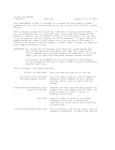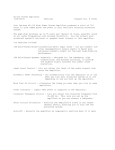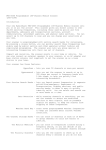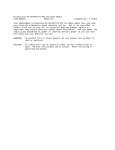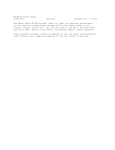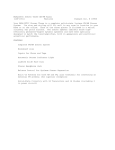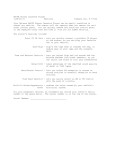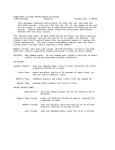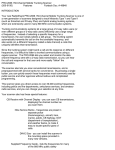Download Realistic 120-1959 Specifications
Transcript
60-Watt Stereo Equalizer/Booster (120-1959) Features Faxback Doc. # 46781 Your Realistic 60 Watt Stereo Equalizer/Booster adds increased dynamic range and clean, high-volume sound reproduction to your auto-sound system. But that is only part of what this unit can do. The 7 band equalizer lets you tailor your system's sound to your vehicle's acoustics and your personal taste. And, the equalizer/booster's many other features (listed below) let you easily expand and control your auto-sound system. 7 Band Equalizer with - gives you control of the basic frequency ranges slide Controls of music. The slide controls provide an instant visual representation of the shape you give the sound. Built-In Fader - lets you easily control the balance between front and rear speakers if you have a four speaker system. Two Types of inputs - let you use the equalizer/booster with a radio or tape player that has line outputs jacks or that only has standard speaker outputs. CD input - lets you easily connect a portable CD player (or any other portable unit with a headphones jack) to the equalizer/booster. Hi/Lo Output Power Meter - shows the output power being used by the left and right channels of your system. You can set the meter range for high or low, depending on your average listening level. Speaker Impedance Control- lets you adjust the booster for optimum performance with 4- or 8-Ohm speakers. 60-Watt Stereo Equalizer/Booster (120-1959) Installation Faxback Doc. # 46782 Included with Your Equalizer/Booster Your equalizer/booster comes with the following items that are necessary for connection and mounting. Be sure to unpack these items before you dispose of the packing materials. Mounting Brackets and Hardware Quantity L-Bracket ..................... 1 M4 Machine Screw .............. 4 M4 Flat Washers ............... 4 M5 Flat Washer ................ 4 R-Bracket ..................... 1 M4 Spring Washer .............. 4 Self-tap Screw ................ 4 M5 Spring Washer .............. 4 Use these to mount the equalizer/booster below the dash of your vehicle. See "Mounting the Equalizer/Booster" below. Installation Note: You can connect this equalizer/booster in many different ways. You can even use it with BLT (balanced transformerless) circuitry. However, improper connections can damage this unit and/or other components in your auto sound system. If, after completely reading this manual, you do not feel confident about installing this unit and have questions such as . . . Does my vehicle have a 12 volt, negative ground electrical system? Which wire is the power wire? How do I connect a wire to the fuse box? . . . we strongly urge you to have this unit installed by a professional auto sound installer. Choosing The Mounting Location We suggest that you connect the wiring and confirm that the equalizer/ booster operates properly with your system before you actually mount it in your vehicle. However, you should choose the mounting location first. Then, when the unit is connected and working properly, you can mount it without re-routing the wires. Choose a mounting location below the dash that: Is as near as possible to your vehicle's radio, tape player, or other main auto sound component. Does not interfere with operation of the vehicle. Is not directly in front of a heating vent. Allows drilling of mounting holes, without damaging other vehicle components. Allows enough leg room for passengers. Allows convenient and safe routing of wires. Then, connect the wiring as follows with the equalizer/booster as close as possible to the chosen location. Wiring Connections CAUTION: If the wiring harness (for power and speakers) on your older existing radio/tape player is not compatible with your new RadioShack equalizer/booster's wiring harness, we suggest that you modify the existing wiring using adapters available at your local RadioShack store. Or, you can have a qualified technician modify the older wiring for you. Modification of your new RadioShack unit will void its warranty. Connecting Power/Speakers to the Equalizer/Booster 1. Before you make any connections, disconnect the positive (+) wire from your vehicle's battery. This reduces the possibility of damage to your system during installation. Note: 2. Connect the equalizer/booster's black (ground) wire to a nearby part of the vehicle's metal frame. Note: 3. You must reset the clock, digital tuner memories for the radio, and any other timer/memory devices when you reconnect the battery wire after wiring is complete. Many parts of modern vehicles are made of plastic or other materials that do not conduct electricity. You must connect the black wire to a metal part that is not insulated from the vehicle's frame by one of these non conducting parts. Connect the speaker wiring harness(es) (not included) to the speakers in your vehicle as shown in Faxback Doc. # 46863, Fig. A. If the speaker wires already exist, you can splice the 5 pin connector for the supplied wiring harness(es) onto the existing speaker wires. These connectors make installation easier and make removal of the equalizer/booster (for service or maintenance) easier. CAUTION: If you use existing speaker wiring or if you run new wires, be sure that chassis ground is not used for any speaker connection. There must be a separate insulated wire for each speaker connection (+ and -). 4. Plug the speaker's wiring harness(es) into the equalizer/booster. sure to connect front and rear speakers as marked. Be 5. Connect the larger red (power) wire with in-line fuse holder to the ACC (Accessory Circuit) position of your automobile's ignition. This connection allows the supply of +12 volt DC power source to be turned on and off with the ignition key. Speaker Tips Your speakers should be capable of handling 40 watts per pair. auto sound speakers are normally sold and rated by pairs. RadioShack With a 4 speaker system, you can use 4- or 8-Ohm speakers. Set the 8-OHM-4 switch on the bottom of the equalizer/booster for the type of speakers you have. Connecting the Equalizer/Booster to Your Existing Auto Sound System (See Faxback Doc. # 46863, Fig. B) If the existing auto sound component (radio or tape player) has RCA-type line output jacks: 1. Connect the radio/tape player's line outputs to the equalizer/booster's LINE INPUT jacks using shielded cables with RCA-type plugs. (Connect left to left and right to right.) 2. Disconnect the square, in line connectors in the equalizer/booster's output wiring harness. 3. Insert the equalizer/booster's output wiring plug into the matching jack on the existing radio/type player (or into the matching jack that you or a qualified technician added to the existing component). If the existing auto-sound component (radio or tape player) does not have RCA-type line output jacks: 1. Be sure that the square, in line connectors in the equalizer/booster's output wiring harness are securely connected. 2. Insert the equalizer/booster's output wiring plug into the matching jack on the existing radio/tape player (or into the matching jack that you or a qualified technician added to the existing component). Installing The Proper Fuses If the fuse for your existing auto sound unit is not rated at 3 amps, replace the fuse in the equalizer/booster's output wiring harness with a fuse that matches the rating of the existing unit's fuse. If the existing unit's fuse is rated at 4 amps or higher, replace the fuse in the equalizer/booster's red power wire with a 15 amp fuse. Testing The Equalizer/Booster Before mounting the equalizer/booster in the location you chose earlier, we suggest that you reconnect the vehicle battery's positive (+) wire and test your entire auto-sound system. See "Operation" in Faxback Doc. # 46783. Mounting The Equalizer/Booster Attach the equalizer/booster as follows in the location you chose prior to connecting the wiring. If you used the supplied wiring harnesses, you can unplug the wires to make mounting more convenient. 1. Attach the left and right mounting brackets to the sides of the equalizer/booster. 2. Using the brackets as a guide, mark the locations for the mounting holes. 3. Drill 3/16 inch holes in the marked locations, using care not to damage anything on the opposite side of the mounting surface. 4. Remove the mounting brackets from the equalizer and attach them to the mounting surface using the supplied self tapping screws. 5. Attach the equalizer/booster to the brackets and plug in the wiring harnesses. 60-Watt Stereo Equalizer/Booster (120-1959) Operation Faxback Doc. # 46783 Turning On The Equalizer/Booster 1. Turn on your radio or tape player and set its volume to a low level. 2. Press the equalizer/booster's POWER button so that the POWER indicator lights. 3. Readjust your radio/tape player's volume control for a normal listening level. Adjusting The Equalizer Adjusting an equalizer is extremely subjective - what sounds best to you might not sound best to some one else. The following procedure covers the basic adjustments. Exactly where to set each control is up to you. 1. Turn on your radio/tape player and the equalizer/booster. 2. Set the radio/tape player's tone (bass and treble) controls to their center positions. 3. Adjust each of the seven slide controls for the best overall sound. Each of the seven slide controls affects the sound around the listed frequency - 60 Hz, 150 Hz, 400 Hz, 1 kHz, 2.4 kHz, 6 kHz, or 15 kHz. Moving the control up increases the sound level around the listed frequency. Moving the control down decreases the sound level around the listed frequency. A center control setting is neutral and has no effect on the sound. The pattern made by the controls shows the approximate shape of the sound output. Using The Fader Control The FADER control is similar to the balance control on your existing radio or tape player. The balance control lets you adjust the balance between the left and right speakers. The FADER control lets you adjust the balance between the front and rear speakers. Turn the FADER control clockwise to emphasize the front speakers. counter-clockwise to emphasize the rear speakers. Turn it Using The Power Meter The POWER METER indicates the approximate amount of power that is being delivered from the equalizer/booster to the speakers. When the METER LEVEL button is out (low setting), use the marked power levels (0.1, 0.3, 1.2, 2.0) to determine the power levels. When the METER LEVEL button is in (high setting) multiply the marked levels by 5 (0.5, 1.5, 3.6, 10.0). Using A Portable CD Player With The Equalizer Booster (See Faxback Doc. # 46863, Fig. C.) You can connect a portable CD player, or any other audio component with a headphone jack, to the equalizer/booster and listen to it through your auto-sound system. You need a patch cable with a 1/8 inch stereo mini phone plug on one end and a plug that matches the portable player's headphone jack on the other end. 1. Turn off the equalizer/booster and the portable CD player (or other component you are using). 2. Plug one end of the patch cable into the equalizer/booster's CD jack and the other end into the CD player (or other portable component). 3. Adjust the CD player's volume control to minimum and begin play of a disc. 4. Adjust the CD player's volume control for the desired listening level. Note: The radio/tape player is internally disconnected from the equalizer/ booster when you plug a patch cable into the CD jack. You must unplug the patch cable to listen to the radio/tape player. 60-Watt Stereo Equalizer/Booster (120-1959) Specifications Faxback Doc. # 46784 Maximum Output power: ............. 30 watts per channel or 60 watts total (with four each 8 Ohm speakers connected) Frequency Response: ............................. 15 - 30,000 Hz, at -3 dB Separation: ........................................................ 50 dB Input Level High Impedance: ................................................ 550 mV Low Impedance: ................................................... 2.7V Total Harmonic Distortion: .............. Less than 1% (at 1 watts output) Equalization Center Frequencies: ................ 60 Hz, 150 kHz, 400 kHz, 1 kHz, 2.4 kHz, 6 kHz, 15 kHz Load Impedance: ......................... 4 Ohm/8 Ohm per speaker terminal Current Drain: ............................................... 10A Maximum Power Supply Voltage: .......................... DC, 14.4V Negative Ground Dimensions (HWD): ................ 19 x 71 x 63 Inches (48 x 180 x 160 mm) Weight: ................................................ 3.52 Lb. (1.6 Kg) (BR/gw 04/07/98) Ln-03/04









